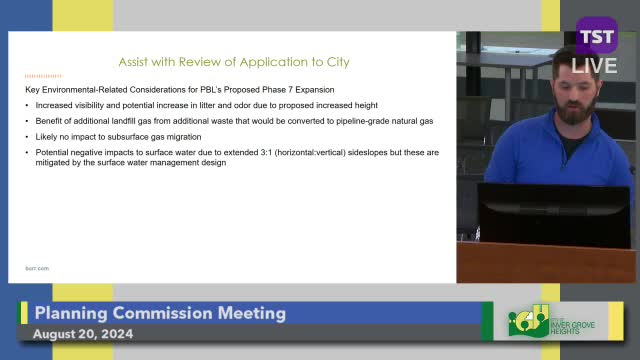Landfill expansion sparks debate over environmental impacts
August 20, 2024 | Inver Grove Heights, Dakota County, Minnesota

This article was created by AI summarizing key points discussed. AI makes mistakes, so for full details and context, please refer to the video of the full meeting. Please report any errors so we can fix them. Report an error »

In a recent government meeting, officials discussed the implications of a proposed 25% increase in capacity at the Pine Bend landfill, which is expected to extend its operational life by approximately 13 years. The meeting highlighted both potential benefits and environmental concerns associated with the expansion.
One of the key points raised was the potential for increased landfill gas production, which could be converted into pipeline-grade natural gas. Officials indicated that this process would not likely affect subsurface gas migration, although there are concerns regarding surface water runoff due to the landfill's new three-to-one slopes. Mitigation measures are planned to address these surface water impacts, as outlined in the application review.
Commissioners sought clarification on the necessity of an environmental impact statement (EIS), with one noting that the Minnesota Pollution Control Agency (MPCA) determined that an EIS was not required for this project. This decision suggests that the landfill's expansion will proceed without the extensive environmental review typically associated with such developments.
Questions were also raised about the landfill's height regulations and the potential for future increases. While officials acknowledged that structural limits would likely prevent further height increases, they noted that current technology could restrict operations within the existing footprint.
The meeting also touched on the sources of waste entering the landfill, with representatives indicating that waste primarily comes from local haulers in Inver Grove Heights and surrounding areas, as well as transfer stations across the state. This influx of waste raises concerns about the long-term environmental impacts, particularly regarding leachate management and surface water quality.
As the discussion concluded, officials emphasized the importance of ongoing monitoring and mitigation strategies to ensure that the landfill expansion does not adversely affect the surrounding environment. The meeting underscored the balancing act between waste management needs and environmental stewardship as the community prepares for increased waste generation in the coming years.
One of the key points raised was the potential for increased landfill gas production, which could be converted into pipeline-grade natural gas. Officials indicated that this process would not likely affect subsurface gas migration, although there are concerns regarding surface water runoff due to the landfill's new three-to-one slopes. Mitigation measures are planned to address these surface water impacts, as outlined in the application review.
Commissioners sought clarification on the necessity of an environmental impact statement (EIS), with one noting that the Minnesota Pollution Control Agency (MPCA) determined that an EIS was not required for this project. This decision suggests that the landfill's expansion will proceed without the extensive environmental review typically associated with such developments.
Questions were also raised about the landfill's height regulations and the potential for future increases. While officials acknowledged that structural limits would likely prevent further height increases, they noted that current technology could restrict operations within the existing footprint.
The meeting also touched on the sources of waste entering the landfill, with representatives indicating that waste primarily comes from local haulers in Inver Grove Heights and surrounding areas, as well as transfer stations across the state. This influx of waste raises concerns about the long-term environmental impacts, particularly regarding leachate management and surface water quality.
As the discussion concluded, officials emphasized the importance of ongoing monitoring and mitigation strategies to ensure that the landfill expansion does not adversely affect the surrounding environment. The meeting underscored the balancing act between waste management needs and environmental stewardship as the community prepares for increased waste generation in the coming years.
View full meeting
This article is based on a recent meeting—watch the full video and explore the complete transcript for deeper insights into the discussion.
View full meeting
